Clergy Reflection: Cantor David Rosen
Parshat P’kudei and The Importance of Individuality within a Community
This time of year always feels a bit frantic. With Spring Break and Purim behind us, Daylight Savings making us sluggish, and Pesach fast approaching, it can all feel like a whirlwind.
And yet, one thing we always find time for is Shabbat… ahhh. And with Shabbat, of course, comes a little Torah. Typically, the Torah portions Vayakhel and P’kudei are read together, but due to how the Hebrew calendar worked out this year, these two portions are getting their own “bimah time” spread over two Shabbatot.
Upon deeper reflection, we find a fascinating paradox in these two parshiot that raises some intriguing questions about our roles as members of this kehillah kedoshah (holy congregation).
The word Vayakhel means “assembly” or “community,” while P’kudei comes from the root meaning “to count” or “accounting,” reflecting a focus on itemization and individuality. In essence, these two parshiot express the intersection and tension between the collective and the individual. On one hand, we recognize the importance of community as part of a greater whole— the Reform movement and the greater Jewish world. Yet, as individuals within this community, we also need to honor our unique identities, distinct from others.
Our Chassidic teachers suggest that the close proximity of these two parshiot is no coincidence, especially since they are often read together. They also point out that both Vayakhel and P’kudei are given equal prominence in the Torah. What’s most striking, however, is how the names of the parshiot seem to have swapped places.
As we saw last Shabbat, Vayakhel describes in intricate detail how the Israelites were to assemble the Mishkan. It talks about the hundreds of decorations, foundations, measurements, accessories, and the individual components of the sanctuary. The word Vayakhel itself comes from kahal, meaning congregation, which underscores the importance of the community coming together.
This week, in P’kudei, we find the opposite approach: a summary of all the parts coming together harmoniously to create the sanctuary’s beauty and completeness. And yet, P’kudei—from the root pakod, meaning “to count”—emphasizes analysis, categorization, and specific details.
So why do the names of these two parshiot seem to have been switched? What can we learn from this apparent contradiction?
Before we attempt to explain the swapping of the names, it’s important to acknowledge the value of both concepts individually, as well as the powerful connection that comes from combining them.
Our congregation is unique and special because each of us brings our own experiences, stories, talents, and skills to the table. We look to each other for inspiration, spiritual growth, and a sense of connection. Each of us has something original and valuable to contribute to our community. I am continually inspired by the new ideas brought forth by my colleagues, our staff members, lay leaders, volunteers, and every individual in the congregation who shares their unique gifts.
Rabbi Jonathan Sacks reminds us of a beautiful blessing from the Talmud, to be recited upon seeing 600,000 Jews in one place (a rare and fortunate occurrence!): “Blessed are You, Adonai, Knower of Secrets.” Judaism, he explains, never allows us to lose our individuality in the mass. The Talmud teaches that every person is different, with their own attributes and thoughts. And God, we are taught, relates to us most intimately as individuals, not as part of an indistinguishable crowd.
And yet, our duality reminds us that our uniqueness is amplified by how we support one another. When we open our hearts and minds to collaboration, we unlock the collective potential of our community. Vayakhel/P’kudei teaches us a delicate balance: the work we do as individuals is strengthened when we come together to benefit the entire community.
We must celebrate the uniqueness of those around us. When we learn from others, when we think in terms of collaboration and building upon each other’s triumphs, we have the power to create a sanctuary that is truly sacred. In doing so, we draw closer to each other, to ourselves, and most importantly, to God.
That still leaves us with the question: Why did the names of the parshiot seem to have switched places? We understand the importance of both individualism and collaboration, but why is community prioritized first?
Our sages teach that even when the goal is the realization of individual potential, the optimal way for an individual to actualize their uniqueness is within the context of a community. The Torah, in placing Vayakhel before P’kudei, teaches us that the first step must always be to bring people together, regardless of their individual state. Personal growth and perfection will follow, nurtured by the love and support we offer one another.
In essence, the content of Vayakhel focuses on the individual components, while P’kudei describes how those parts come together to form a greater whole. The Torah tells us that the most perfect community is one that brings together individuals who are fully in touch with their own uniqueness, while also recognizing the importance of working together to create something greater. True community is not just a sum of its parts; it is the beauty that emerges when each part has its opportunity to shine in a supportive environment that is guided by Divine presence.




Leave a Reply
Want to join the discussion?Feel free to contribute!